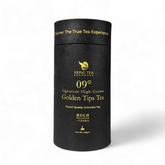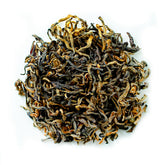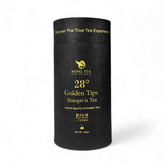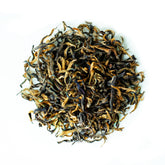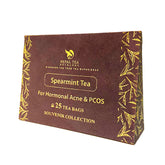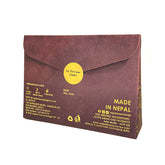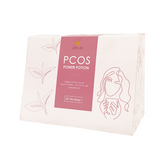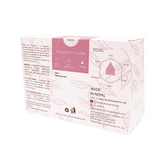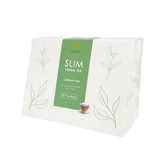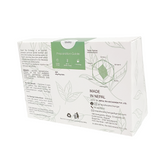The Himalayan Brew: How Nepal’s Tea Is Carving Its Identity Beyond Darjeeling
The search for good organic tea brands increasingly leads connoisseurs to Nepal, where annual tea production exceeds 26,000 metric tons. Despite having 1.8 million hectares of land suitable for orthodox tea cultivation, only 20,237 hectares are currently under production. Nevertheless, Nepal's tea exports have surged by over 40% in recent years, reflecting growing international demand for this Himalayan brew.
Nepal's tea production encompasses two primary varieties: CTC (Crush, Tear, Curl) and Orthodox tea. Particularly noteworthy is Ilam tea, which is more potent in promoting heart health and reducing inflammation than its famous neighbor, Darjeeling tea. Meanwhile, approximately 10 percent of the orthodox teas produced in Nepal are organic, with another 10 percent classified as specialty teas including white tea, oolong tea, and silver and golden tip varieties. These unique offerings are finding their way to diverse markets including India, Pakistan, Australia, Germany, France, and the United States. In fact, the global tea market is shifting toward unique, artisanal products that offer distinct flavors and ethical production methods, positioning Nepal's tea industry for continued growth on the world stage.
Ilam Tea Gains Global Attention
Located in eastern Nepal's hills, Ilam has emerged as a premier tea-growing region gaining recognition across global markets. Nestled against the Himalayas, this region produces exceptional quality teas with distinctive characteristics that increasingly appeal to connoisseurs seeking good organic tea brands.
How Ilam's climate shapes its tea profile
Ilam's tea gardens thrive at elevations between 1,000 to 2,500 meters (3,300 to 8,200 feet) above sea level. This high-altitude environment creates optimal growing conditions with significant day-night temperature variations that intensify flavor development in the leaves. The region's cool climate, rich soil, and misty environment contribute to the slow growth of tea leaves, substantially enhancing their flavor and aroma profiles.
Furthermore, the diurnal temperature shifts to warm days followed by cool nights naturally increases volatile aroma compounds and sweetness. This climate pattern, combined with mineral-rich slopes, adds subtle complexity and creates a clean finish that distinguishes Ilam's teas. Additionally, snow-fed streams and natural mountain springs provide year-round irrigation to the tea gardens.
Why Ilam tea is often compared to Darjeeling
Ilam and Darjeeling share geographical proximity as well as similar climatic conditions, hence the frequent comparisons between their teas. Both regions cultivate the Chinese variety of Camellia sinensis tea plants and benefit from comparable high-altitude growing environments. Consequently, they both exhibit the prized "muscatel" flavor, a sweet, grape-like taste highly valued by tea enthusiasts.
What makes Ilam tea unique in flavor and aroma
Ilam tea possesses a distinctive flavor profile characterized by:
- A slightly nutty and floral taste with subtle sweetness
- Fruity undertones and exceptional aromatics
- Clean, crisp finish with less bitterness than many other teas
The organic farming practices prevalent in Ilam further contribute to its unique taste. Unlike heavily industrialized tea production, Ilam's approach emphasizes hand-harvesting and traditional processing methods that preserve the leaves' integrity. The result is a tea that balances vivid flavor with gentleness "perfumed without harshness and sweet without stickiness".
Nepal Embraces Orthodox Tea Traditions
Traditional craftsmanship defines Nepal's approach to tea production, with the country primarily focusing on orthodox tea varieties that preserve distinctive flavors. This heritage-based approach sets Nepali tea apart in global markets and establishes its reputation among good organic tea brands worldwide.
What is orthodox tea and how is it made?
Orthodox tea refers to traditional tea-making processes that involve hand or semi-hand processing techniques that maintain the tea leaves' integrity. Initially introduced to Nepal in 1863 with seeds gifted by the Chinese Emperor to Prime Minister Jung Bahadur Rana, orthodox tea production follows a meticulous process requiring significant skill.
The production begins with precise plucking, selecting only the top two leaves and bud ("fine pluck") from each branch. Subsequently, the leaves undergo withering for 12-17 hours to reduce moisture content. Afterward, the withered leaves are rolled either manually or mechanically, breaking cell walls to release enzymes and initiate oxidation. Oxidation follows, developing the tea's flavor profile before the leaves are dried to halt this process and preserve aroma compounds.
How traditional processing enhances quality
Traditional processing methods specifically contribute to Nepal's orthodox tea quality through careful handling that preserves essential oils and compounds. While CTC (Crush, Tear, Curl) processing focuses on quick production, orthodox methods prioritize flavor complexity.
The controlled oxidation phase essentially determines the tea's final character, creating distinct varieties based on oxidation levels. Green tea undergoes minimal oxidation, whereas black tea experiences extensive oxidation, resulting in diverse flavor profiles. This traditional approach yields teas with layered notes of "honey, malt, red grape, apricot, toasted walnut" and a "smooth finish".
Why smallholder farmers are key to Nepal's tea identity
Small-scale producers form the backbone of Nepal's tea industry. Currently, 98.8% of Nepal's tea producers are smallholder farmers, with 82% cultivating less than one hectare of land. Certainly, this model offers advantages in a country with strict labor regulations, as it reduces labor liabilities while maintaining production efficiency.
These farmers primarily operate in eastern Nepal, where they contribute 68% of total tea production across the region. Their transition from subsistence farming to tea cultivation has significantly reduced poverty and increased food security in rural areas. Since gaining its own trademark in 2020 "Nepal Tea Quality from the Himalaya" Nepal's orthodox tea has established a distinct identity in international markets. This trademark represents a collective effort by smallholder farmers to brand their product independently rather than being overshadowed by more established tea regions.
Sustainability Drives Nepal’s Tea Appeal
Sustainability practices form the cornerstone of Nepal's rising tea industry, propelling Nepali teas into premium markets worldwide. Environmental consciousness coupled with traditional cultivation methods creates products that appeal to health-conscious consumers seeking good organic tea brands.
How organic farming boosts health and flavor
Organic cultivation methods primarily avoid synthetic pesticides and fertilizers, allowing tea plants to develop naturally. This absence of chemicals enhances the tea's health benefits while preserving its natural flavor profile. Organic teas from Nepal typically contain higher antioxidant levels than conventionally grown varieties, offering enhanced protection against oxidative stress.
Notably, the natural cultivation approach allows tea leaves to develop more complex flavor compounds. Without chemical interference, the plants produce stronger defensive compounds that translate into richer taste profiles with distinct notes often described as "cleaner" and "more authentic."
What eco-friendly practices are used in Ilam
Ilam's farmers employ several key sustainable methods:
- Intercropping tea with nitrogen-fixing plants to maintain soil fertility
- Using natural pest control methods including neem extracts and beneficial insects
- Implementing terraced farming techniques that prevent soil erosion on hillsides
- Conserving water through rainwater harvesting systems
These practices help maintain biodiversity throughout the region while protecting the delicate Himalayan ecosystem.
Why global consumers prefer sustainable teas
Today's tea drinkers increasingly demand products aligned with environmental values. This shift toward sustainability stems from growing awareness about climate change impacts and health concerns regarding chemical residues in food products. Consequently, many consumers willingly pay premium prices for certified organic teas that support fair trade practices and environmental preservation values deeply embedded in Nepal's emerging tea identity.
Global Markets Shift Toward Nepali Tea
Nepal's tea exports are currently shifting beyond traditional markets, with diversification efforts yielding promising results. Export values reached Rs3.8 billion in fiscal year 2021-22, increasing by Rs140 million the following year.
How Nepal tea is gaining traction in Europe and the US
After India, Germany has become the largest market for Nepali orthodox tea, importing 22 tons worth Rs60 million in just eight months of the current fiscal year. Alongside Germany, the Czech Republic purchased 13 tons worth Rs24.95 million. Orthodox tea has expanded to multiple European countries including Bulgaria, Italy, Netherlands, and the UK. In the American market, exports to the US reached NPR 42569.25 thousand during 2022.
Why China is emerging as a key buyer
Chinese interest in Nepali tea has intensified recently, with export volumes jumping 88.31% to Rs10.53 million. Indeed, China has offered zero-tariff treatment on 98% of taxable products from Nepal, including tea. Chinese traders have been visiting Nepal's tea gardens in increasing numbers, primarily interested in orthodox and specialty varieties.
What challenges remain in branding and certification
Although international demand grows, certification issues persistently hinder exports. Strict quality standards in European markets require testing that Nepal lacks domestically. Furthermore, the absence of tea-testing labs forces producers to use Indian facilities. Despite receiving its trademark in 2020, many good organic tea brands from Nepal still struggle with proper market recognition.
Conclusion
Nepal's remarkable journey in the global tea market demonstrates how tradition meets opportunity in the Himalayan region. Despite utilizing only a fraction of its suitable land for tea cultivation, exports have surged by over 40% in recent years. Undoubtedly, Ilam tea stands as the crown jewel of Nepali tea production, offering distinct flavor profiles that rival its renowned Darjeeling neighbor. The region's unique geographical advantages, high altitude, temperature variations, and mineral-rich soil contribute to its exceptional quality.
Traditional orthodox processing methods, though labor-intensive, significantly enhance the complexity and character of Nepal's teas. Smallholder farmers, who form nearly 99% of tea producers, remain essential to maintaining this artisanal approach while establishing a distinct identity through the "Nepal Tea Quality from the Himalaya" trademark.
Equally important, sustainability practices have positioned Nepali tea advantageously in a market increasingly driven by environmental consciousness. Organic farming methods not only boost health benefits but also develop more complex flavor compounds that appeal to discerning palates worldwide.
Though challenges persist regarding testing facilities and international certification, Nepal's tea industry continues to expand its global footprint. Germany, Czech Republic, and other European countries have emerged as significant markets alongside the traditional Indian buyers. Furthermore, China's growing interest presents exciting opportunities, particularly with its zero-tariff treatment on Nepali tea products.
Looking ahead, Nepal's tea industry stands poised for continued growth by balancing traditional craftsmanship with modern market demands. The Himalayan nation's unique approach to tea cultivation and processing, coupled with its commitment to sustainability, ensures its distinct place on the world stage not as a substitute for other teas but as a premium offering with its own remarkable identity.
Key Takeaways
Nepal's tea industry is rapidly establishing itself as a premium global player, moving beyond comparisons to Darjeeling through unique terroir, sustainable practices, and traditional craftsmanship that appeals to modern consumers.
- Ilam's high-altitude climate creates exceptional tea quality - Elevations of 1,000-2,500 meters with temperature variations produce complex flavors and muscatel notes that rival Darjeeling.
- Orthodox processing preserves authentic flavors and heritage - Traditional hand-processing methods by 98.8% smallholder farmers maintain tea leaf integrity and develop layered taste profiles.
- Organic farming drives premium market appeal - Chemical-free cultivation enhances antioxidant levels and creates cleaner flavors that satisfy health-conscious global consumers.
- Export diversification shows promising growth - Beyond India, Germany leads European imports while China emerges as a key buyer with zero-tariff treatment opportunities.
- Certification challenges limit full market potential - Despite 40% export growth, lack of domestic testing labs and quality certification infrastructure hinders expansion into premium markets.
Nepal's "Quality from the Himalaya" trademark represents more than branding; it symbolizes a nation's commitment to sustainable, artisanal tea production that honors tradition while meeting modern market demands for authenticity and environmental responsibility.
FAQs
Q1. What makes Ilam tea unique compared to other teas?
Ilam tea is known for its distinctive flavor profile, characterized by a slightly nutty and floral taste with subtle sweetness, fruity undertones, and exceptional aromatics. It's grown at high altitudes in Nepal, which contributes to its complex flavor and clean, crisp finish.
Q2. How does Nepal's tea production differ from traditional tea-producing countries
Nepal's tea production is primarily focused on orthodox tea varieties, which involve traditional hand or semi-hand processing techniques. This approach preserves the tea leaves' integrity and results in teas with layered flavors and aromas. Additionally, 98.8% of Nepal's tea producers are smallholder farmers, contributing to the unique character of Nepali teas.
Q3. What sustainable practices are used in Nepal's tea production?
Nepal's tea industry emphasizes organic farming methods, which avoid synthetic pesticides and fertilizers. In Ilam, farmers use eco-friendly practices such as intercropping with nitrogen-fixing plants, natural pest control methods, terraced farming to prevent soil erosion, and rainwater harvesting systems for water conservation.
Q4. How is Nepal's tea industry expanding in the global market?
Nepal's tea exports have surged by over 40% in recent years, with growing demand in European countries like Germany and the Czech Republic. China has also emerged as a key buyer, offering zero-tariff treatment on Nepali tea. The industry is gaining recognition for its unique flavors and sustainable production methods.
Q5. What challenges does Nepal's tea industry face in the international market?
Despite growing demand, Nepal's tea industry faces challenges in certification and quality testing. The country lacks domestic tea-testing labs, forcing producers to use Indian facilities. Additionally, meeting strict quality standards in European markets requires testing capabilities that Nepal currently lacks, hindering full market potential.


